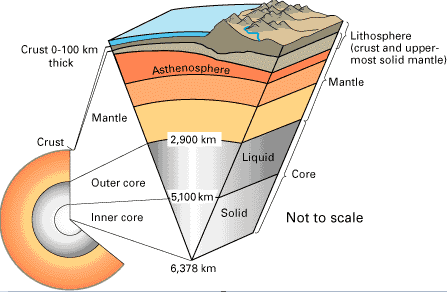1. Igneous Rock formation:
Hypabyssal Rock: Hypabyssal rocks are formed when consolidation of magma takes place very close to the earth’s surface in the form of smaller sheet like bodies (known as sills and dykes) that fill cracks inside other rocks.
Some extrusive generally have finer grained, smoother surfaces. Some extrusive materials, such as volcanic ash, bypasses the rock stage and forms directly into sediment
Common Igneous Rocks
Some common igneous rocks include:
Granite: is coarse grained, an intrusive rock. It the most common and familiar igneous rocks. Granite contains primarily orthoclase feldspar and quartz, with some biotite and amphibole. It is mostly light in color with a white or pink tint according to the color of the feldspar.
Engineering properties
Granite have as low as 0.24 per cent. It as an excellent frost resistance. Because of the minerals composition and interlocking of crystals, granite is hard and abrasion resistant. The compressive strength of granite is on average 24,500 psi. it can be concluded that granite can be used to support any load of ordinary structures.
Diorite: is coarse grained, an intrusive rock. It is mainly composed of plagioclase feldspar (more than 50 %) and hornblends. However, in some varieties augite and biotite may be present. It is more abundant than syenites but less abundant than granite.
Diorite has been used for crushed stone for monumental and decorative purposes than for structural purposes.
Syenite: is grained igneous rocks composed essentially of potassium felspare (80-85 %). Biotite and hornblende are commonly present. Quartz is present in small amount. The general properties of syenites is similar to grainite. Because of the rarity of syenite, it is of little commercial use as structural material.
Some other types of igneous rocks are: Rhyolite, Pumice (can be used as pozzolanic materials with cement), Dolerite, Basalt and Gabbro.
Texture: Texture is size, shape and arrangment of mineral grains in a rock. Texture of rock can either of coarse-crystalline or it can be glassy or amorphus. The texture of the rock is governed by the cooling time of the magma. Crystallization is govened by slow cooling, however, glassy texture or amorphous form is the result of rapid cooling.
Types of rock: Holocrystalline, Coarse grained, fine grained, cryptocrystalline and glassy (amorphus)
Dike and sill
Sill: A sill is igneous rock which very in thickness from a few centimeter to several hundred meters. The sill is parallel to the bedding of rock and may be horizontal, inclined or vertical depending upon the strata.
Dike: A dike is vertical wall-like igneous body that cuts the bedding of the rock. The thickness of the dike may vary from a few centimeters to a hundred meter or more.
2. Sedimentary Rocks formation
Sedimentary rock is formed by deposition and consolidation of mineral and organic material and from precipation of minerals from solution. The processes that form sedimentary rock occur at the surface of the earth and within bodies of water. Rock formed from sediments covers 70-80 % of the earth’s land area, and includes common types such as limestone, chalk, sandstone, conglomerate and shale.
Mechanically formed: consisting of materials (gravels, sand, silt and clay) suspended in flowing water. The suspended materials are then deposited and consolidated. The mechanically formed sedimentary rocks are of three types:
- Rudaceous rocks which is the cementing together of boulders, for example, conglomerate.
- Arenaceous rocks for example sandstone,
- Argillaceous rocks which clay rocks for example shale
- Organically formed: Consisting of accumlated animals and plants remains. They are:
- Calcarious rocks, lime stone
- Carbonaceous rocks, coal
- Chemically formed: this type of rocks is formed by precipitation and accumulation of soluble constituents. These are Carbonate rocks, Limestone, dolomite, Sulphate rocks, Gypsum, Chloride rocks, salt
Consolidation
Consolidation is a process by which soft and loose sediments are converted into hard and firm rocks. Consolidation is of three types:
Compaction and Dehydration: The squeezing out of water from the pores of the sediments and its changing to solid mass by cohesion between the particles and pressure from overlying rock is called compaction and dehydration.
Cementation: Many coarse grained sediments are consolidated by cementation, which is the process of precipitation of some cementing materials, for example, silica, calcium carbonate, iron oxides and clay minerals.
Crystallization: Chemically formed sedimentary rocks such as limestone, dolomites, gypsum etc are consolidated chiefly by the crystallization of their constituents.
Structural Features of sedimentary rocks
- Structural features of sedimentary rocks are of great value in determining their origin. The main structures are as follows:
- Stratification: The deposition of sediments into layer or beds is called stratification. The thickness of a single bed may vary from a few centimeters to many meters. The stratification is formed due to the following.
- Difference in the kinds of materials deposited for example shale and lime stone
- Difference in the size of particles deposited for example coarse grained and fine grained stand stone beds
- Difference in the color of the material deposited for example light grey and dark grey layers of limestone
- Lamination: Thin bedding, less than one centimeter in thickness, are called lamination. It is usually fined grained sedimentary rocks like shales.
- Cross-bedding: It is also called current bedding or false bedding. Cross-bedding are the minor bedding or lamination which lie at an angle to the planes of general stratification. This structure is found in shallow water and wind formed deposites.
Different types of sedimentary rocks
Conglomerate: The pebbles and gravels on consolidation and cementation produce a rock known as conglomerate. Gravels are deposited for the most part by water. Water circulating through gravel deposits may precipitate out silica, calcium carbonate, or iron oxides, which act as cements binding the gravels together into conglomerates.
Sandstones: Most sand is a water deposit. In arid regions, widespread sands have been laid down by wind action. Volcanic eruptions, glacial action, mechanical and chemical weathering, and organisms produce sands. The sand particles are deposited and then cemented together by materials like silica, calcite, iron oxide or clay. Sandstones may be siliceous sandstone that is the cementing materials is silica; it may be calcarious sandstone in which the cementing materials is calcium carbonate; ferruginous sandstone and argillaceous sandstone having iron oxide and clay as cementing materials
The thoroughly cemented sandstone with quartz are termed as orthoquartzite.
Argillaceous rocks: variously called mudstone, claystone, and shale (compacted or cemented) are among the most abundant of sedimentary rocks. It is a laminated fine grained sedimentary rock which is mainly composed of clay minerals and some silt-size grains of quartz.
The claystones, because they are characteristically soft and weak are not suited to most construction purposes. The compacted shale lose strength when wet and are subject to plastic deformation. Under load they are subject to failure by flow. The cemented shales have a strength comparable to concrete but have a relatively high elasticity. Clay stones underlying the sites of heavy structures should be test in both wet and dry conditions. Clay stone has a limited use. It serves as a raw materials for the ceramic industry in some places and also used as raw materials for cement production.
Carbonate rocks: The carbonate rocks are chiefly the products of marine or fresh water sedimentation. They are predominantly chemical sediments either formed by metabolic process of organism or precipitated inorgainically. Mineralogically, the carbonate rocks are comparatively simple. There are two main varieties; the limestone composed chiefly of the calcite, and the dolomite composed chiefly of dolomite.
The carbonate rocks, particularly the limestones, have a very wide use in modern industry. The largest single use is as crushed stone. Limestone is one of the leading dimension stones being utilized both for internal and external work. Commercial lime is derived from the burning of limestone.
3. Metamorphic rock formation
When the pre-existing rocks (sedimentary or igneous rock) are subjected to increased temperature, pressure and action of chemically active fluids, metamorphic rocks are formed. During metamorphism re-crystallization of mineral constituent takes place, as a result new minerals and new texture are produced.
The metamorphic processes generally improve the engineering behavior of these rocks by increasing their hardness and strength. Nevertheless, some metamorphic rocks still can be problematic. Some metamorphic rocks are foliated , which means they have oriented grains similar to bedding plains in sedimentary rocks. These foliation is important because the shear strength is less for stresses acting parallel to the foliation.
Types of Metamorphism
Contact metamorphism is the name given to the changes that take place when magma is injected into the surrounding solid rock. The changes that occur are greatest wherever the magma comes into contact with the rock because the temperature are highest at this boundary and decrease with distance from it. Around the igneous rock that forms from the cooling magma is a metamorphosed zone called a contact metamorphism aureole.
Regional metamorphism is the name given to changes in great masses of rock over a wide area. Rock can be metamorphosed simply by being at great depths below the earth’s surface, subjected to high temperatures and the great pressure caused by the immense weight of the rock layers above. Much of the lower continental crust is metamorphic.
Different Metamorphic rocks
Marble: Marbles are metamorphosed carbonate rocks, derived from limestones and dolomites. The color of marble is variable, however, if the rock is pure calcite or dolomite marble it is generally white. Various impurities give rise to various shades. Green, pinks and buffs are common shades.
The principal uses of marble are as cut stone for building and ornamental or decorative use.
Slate: Slate is a dense metamorphic rock, with a strongly developed foliation. It is produced by the metamorphism of shale. The rock cleavage, or splitability is therefore excellent and is the outstanding characteristic of slates. The color of slate varies from iron-tinted reds through various shades of gray and green. The gray shades are due to carbonaceous matter, the greens to chloritic micas. The texture of slates is very fine or dense and foliation is good to perfect.
Slate is used widely in the electrical industries as switchboards.
Phyllite: Phyllite are strongly foliated metamorphic rocks similar to the slates but of slightly coarser texture. Phyllite have shiny luster due the presence of large amount of fine flakes of mica. Phyllite gradually pass into slates which are the first stage in the metaphorphism of shale.
It has little use. It is too soft for crushed stone, and too weak for structural uses.
Schist: Schist are foliated metamorphic rocks of medium to coarse texture. They are the product of the same processes of rock flow and recrystallization that produce slates and phyllite. The color of schist vary according to the mineralogical composition, as does also the perfection of cleavage.
Schist has of little use. Because of the foliation, they are generally weak rocks. Some schists especially rich in muscovite are a source of scrap mica.
Some common metamorphic transformation
Original
|
Sedimentary Rock
|
Metamorphic Products
|
Clay
|
Shale
|
Slate, phyllite, schist
|
Marl
|
Limestone
|
Marble
|
Impure lime mud
|
Calcareous shale, or impure lime stone
|
Lime silicate rocks
|
Sand
|
Sandstone
|
Quartzite
|
Granite
|
|
Granite gneiss
|
Basalt
|
|
Greenstone, chorite schist, hornblend schist
|
| 


























